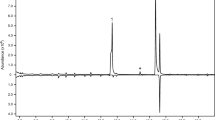Abstract
The bark weevilPissodes nemorensis, a pest of pines and exotic cedars in the southeastern United States, utilizes a male-produced aggregation pheromone. The presumed pheromone components, grandisol (cis-2-isopropenyl-1-methylcyclobutaneethanol) and its corresponding aldehyde, grandisal, were isolated from extracts of male volatiles and male hindguts. A field test in northern Florida showed that the combination of grandisol, grandisal, and slash pine (Pinus elliottii) bolts acted synergistically to attract large numbers of male and femaleP. nemorensis. These components deployed in various paired combinations were not as attractive as the tripartite mixture. There was no evidence that flying weevils were attracted to unbaited pine bolts. The aggregation pheromone forP. nemorensis appears to be similar to that of a parapatric sibling species,P. approximatus.
Similar content being viewed by others
References
Atkinson, T.H. 1979. Bionomics ofPissodes nemorensis (Coleoptera: Curcuiionidae) in north Florida. PhD thesis. University of Florida, Gainsville. 100 pp.
Baker, W.L. 1952. Eastern Forest Insects. U.S. Dept. Agric. For. Serv. Misc. Publ. No. 1175. 64 pp.
Beal, J.A. 1952. Forest insects of the southeast: With special reference to species occurring in the Piedmont Plateau of North Carolina. Duke University, School of Forestry, Bull. 10. 178 pp.
Bedard, W.D., andBrowne, L.E. 1969. A delivery trapping system for evaluating insect chemical attractants in nature.J. Econ. Entomol. 62:1202–1203.
Booth, D.C. andLanier, G.N. 1974. Evidence of an aggregation pheromone inPissodes approximatus andP. strobi. Ann. Entomol Soc. Am. 67:992–994.
Booth, D.C., Phillips, T.W., Claesson, A., Silverstein, R.M., Lanier, G.N., andWest, J.R. 1983. Aggregation pheromone components of two species ofPissodes weevils (Coleoptera: Curculionidae): Isolation, identification, and field activity.J. Chem Ecol. 9:1–12.
Byrne, K.J., Gore, W.E., Pearce, G.T., andSilverstein, R.M. 1975. Porapak-Q collection of airborne organic compounds serving as models for insect pheromones.J. Chem. Ecol. 1:1–7.
Finnegan, R.J. 1958. The pine weevil,Pissodes approximatus Hopk., in southern Ontario.Can. Entomol. 90:348–358.
Fontaine, M.S. 1981. Reproductive ecology of the deodar weevil,Pissodes nemorensis (Coleoptera:Curculionidae), in north Florida. MS thesis. University of Florida, Gainsville. 100 pp.
Fontaine, M.S., andFoltz, J.L. 1982. Field studies of a male-released aggregation pheromone inPissodes nemorensis.Environ. Entomol. 11:881–883.
Fontaine, M.S., Foltz, J.L., andNation, J.L. 1983. Reproductive anatomy and seasonal development of the deodar weevil,Pissodes nemorensis (Coleoptera: Curculionidae), in north Florida.Environ. Entomol. 12:687–691.
Heikkenen, H.J., andHrutfiord, B.F. 1965.Dendroctonus pseudotsugae: A hypothesis regarding its primary attractant.Science 150:1457–1459.
Jones, B.F. 1965. The biology of the deodar weevil,Pissodes nemorensis. MS thesis. University of Arkansas, Fayetteville. 51 pp.
Moeck, H.A., Wood, D.L., andLindahl, K.Q. 1981. Host selection behavior of bark beetles (Coleoptera: Scolytidae) attackingPinus ponderosa, with special emphasis on the western pine beetle,Dendroctonus brevicomis, J. Chem. Ecol. 7:49–83.
Ollieu, M.M. 1971. Damage to southern pines in Texas byPissodes nemorensis.J. Econ. Entomol. 64:1456–1459.
Overgaard, N.A., andNachod, L.H. 1971. Deodar weevil causes pine mortality in Louisiana.J. Econ. Entomol 64:1329–1330.
Phillips, T.W. 1981. Aspects of host preference and chemically mediated aggregation inPissodes strobi (Peck) andP. approximatus Hopkins (Coleoptera: Curculionidae). MS thesis. State University of New York, College of Environmental Science and Forestry, Syracuse. 94 pp.
Phillips, T.W., andLamer, G.N. 1984. Interspecific activity of aggregation pheromones among closely related species ofPissodes. In preparation.
Williams, H.J., Silverstein, R.M., Burkholder, W.E., andKhorramshahi, A. 1981. Dominicalure 1 and 2: components of aggregation pheromone from male lesser grain borerRhyzopertha dominica (F.) (Coleoptera: Bostrichidae).J. Chem. Ecol. 7:759–780.
Wood, D.L. 1982. The role of pheromones, kairomones, and allomones in the host selection and colonization behavior of bark beetles.Annu. Rev. Entomol. 27:411–446.
Zeng, X.-N. 1983. Acid catalyzed rearrangement of grandisol, a component of the aggregation pheromone of severalPissodes species; and following the course of resolution of carboxylic acids by [13C]NMR spectrometry of amine salts. MS thesis. State University of New York College of Environmental Science and Forestry, Syracuse. 108 pp.
Author information
Authors and Affiliations
Rights and permissions
About this article
Cite this article
Phillips, T.W., West, J.R., Foltz, J.L. et al. Aggregation pheromone of the deodar weevll,Pissodes nemorensis (Coleoptera: Curculionidae): Isolation and activity of grandisol and grandisal. J Chem Ecol 10, 1417–1423 (1984). https://doi.org/10.1007/BF00990312
Received:
Revised:
Issue Date:
DOI: https://doi.org/10.1007/BF00990312




